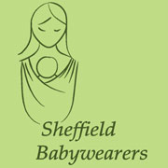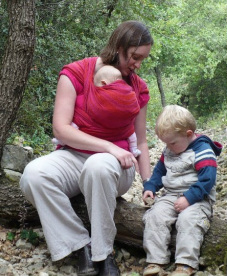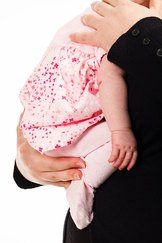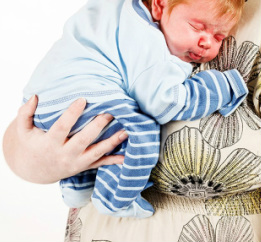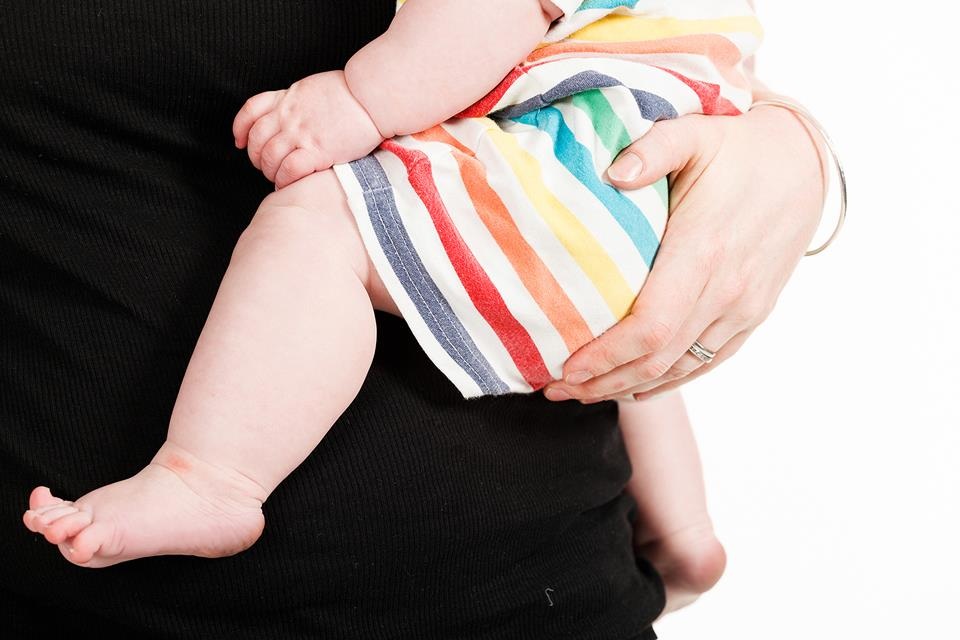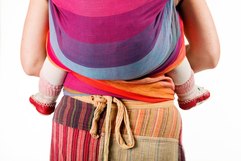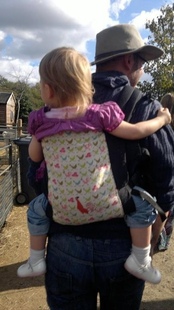Good positioning in a baby sling or baby carrier
Try this - lift your child up, whatever age he is, hold him to you, and look in the mirror. Note the way he holds his legs. Ideally, your baby sling should support him in this natural leg position. Slings that do not support this position are less than ideal. There is conflicting research on the subject, but we believe that it is safest to support a child to sit in the way he does naturally. Anything else cannot be guaranteed not to be damaging his joints.
For safe babywearing, you should always make sure your sling supports your baby's head and back. If he cannot hold his head up on his own, make sure the sling prevents his head falling backwards. And if you can push your baby towards you by pressing on his back, the sling isn't tight enough and is not providing enough support of his back or his airway.
For safe babywearing, you should always make sure your sling supports your baby's head and back. If he cannot hold his head up on his own, make sure the sling prevents his head falling backwards. And if you can push your baby towards you by pressing on his back, the sling isn't tight enough and is not providing enough support of his back or his airway.
|
Newborns
A newborn baby's natural position is with her legs curled up and her back in a C-shape. This is how she was in the womb and it will be several weeks before she uncurls. Therefore, when slinging a newborn, you may like to keep her legs and feet tucked inside the sling, making sure they are folded up on either side of her torso, just like they are when you lie down with her on your chest. A well-tied or adjusted sling will form a lovely pouch to support her bottom and keep her tight against you, so she won't fall out and her back is supported. The sling should support her back right up to the top of the spinal column, but without impeding her breathing. It's good to keep a newborn upright unless you're completely sure of what you're doing. A cradle hold, where the baby is tilted, is possible, but you must be extra-careful of your TICKS rule. It's all too easy in such a carry to allow the baby to curl up, chin to chest, with her face hidden away, and it's hard to get her close enough to kiss. Keep the baby tummy to tummy with you, and avoid holds in which the baby is horizontal, such as those that mimic breastfeeding positions. |
|
We highly recommend that you read this document from The Babywearer to get more information before you carry your newborn.
|
Older infants
As your baby gets older, you'll notice his legs start to stretch out, and when you pick him up you'll find yourself supporting him under his thighs as well as his bottom as he straddles your middle. It is time to go "legs out" in your sling to allow him a bit more leg room. Make sure that whatever sling you're using, it supports the whole of his thighs and bottom. This means that the base of the sling, or the pouch you create, must go from knee to knee. You may think that your baby's legs are being spread very wide, but this is fine. Again, pick up your baby and look in the mirror, and you'll see that this is how he naturally moulds to you. |
|
|
Also, always make sure that his knees are higher than his bottom. This is how he normally sits, because his hips aren't fully developed. You should support this to make sure that his joints develop correctly and that his back isn't over-straightened. You want to make an "M" shape with his legs and bottom.
See this page from the Hip Dysplasia Institute for some useful pictures of good positioning, and also this page from Carried with Love. |
|
Toddlers and older children
Slinging a toddler is not really any different from slinging an infant, except that your own comfort becomes more important (there's a bit more weight to be carried!), and head support becomes less important. If you've been using a baby-size SSC or mei tai, you may want to look into getting a toddler-size one. If your child is starting to get red marks on the underside of her thighs where the edge of the seat digs in, it's time for a larger sling. A woven wrap will always fit, but again as your child gets heavier you may find you want to move on to a more supportive weave or fibre blend. For a child that can walk, you can get away with positioning that is not knee-to-knee, as a toddler's bones and muscle tone are now pretty strong. Knee-to-knee is still best as it promotes the "M" shape of the legs, but don't worry if the positioning isn't optimal as long as your child isn't complaining - if she isn't comfortable, she will tell you. However, you may find a larger sling to be better for you, as the more a child's legs straddle your body, the easier she will be to carry. Legs hanging down will make the weight pull on your shoulders rather than being distributed over your back. |
|
